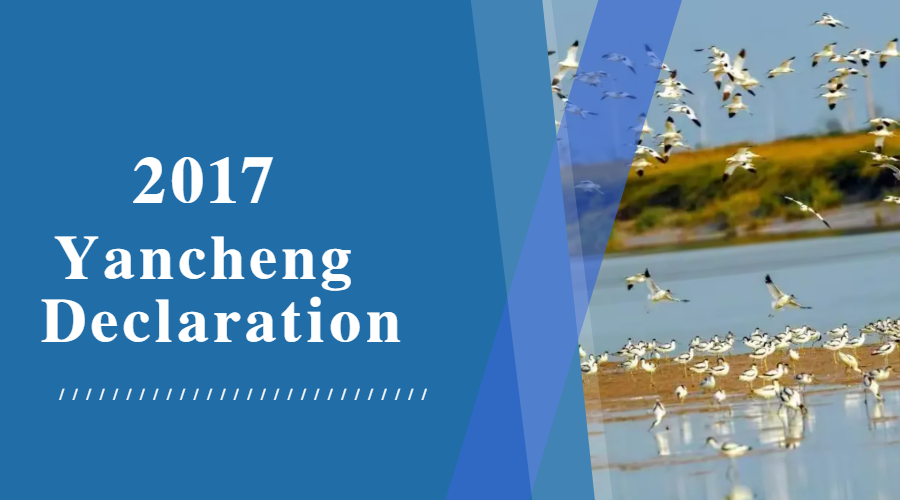
The Yancheng International Symposium on the Conservation and Management of the Intertidal Wetlands of the Yellow and Bohai Seas, was held from 13 to 14 December 13-14, 2017 in the Dongjiao State Guest Hotel, Yancheng.
The symposium brought together over 100 guests from home and abroad from governments, major international organizations, academic institutions and enterprises in the field of world natural heritage identification and management, wetland conservation and protection, bird migration and conservation, and sustainable development. Questions addressed by participants included: How to protect wetland ecosystems and rare and endangered species based on sound scientific evidence? How to highlight the potential outstanding universal value the Yellow Sea in a World Heritage nomination? How to achieve a unified approach and work together to promote ecological green and sustainable development? These and other issues were the subject of warm and fruitful discussions, which led to the following outcomes:
1. The nomination of the intertidal wetlands of the Yellow and Bohai seas for inscription on the World Heritage List.
The Yellow and Bohai seas region is home to Asia’s largest and most important intertidal wetlands, which form a crucial link in the East Asian-Australiasian Flyway and one of the world’s largest ranges of migratory water birds. Its significant ecological value forms a scientific basis for the region’s nomination as a World Heritage site in recognition of its potential Outstanding Universal Value (OUV). During the Yancheng Symposium, for the first time, representatives of the relevant national governments joined forces to further explore the various options for a World Heritage nomination, and for enhanced international coordination on the conservation and management of intertidal wetlands in the region. Representatives advocate relevant countries and regions to formulate species conservation mechanisms and standards in line with the provisions of the World Heritage Convention.
2. The joint conservation of the region’s intertidal wetlands ecosystems and the wildlife that depends on them.
This is a critical issue for the governments responsible for managing and sustaining wetlands in the region. In the past 50 years the wetland area of the Yellow and Bohai seas have declined by about 66 percent. The wetlands ecosystems and the migratory birds that depend upon them have been significantly impacted by the reclamation of land for development. Some iconic water-bird species are Endangered or even Critically Endangered according to the IUCN Red List of threatened species. Other critical factors that have impacted on the wetland’s ecological health include water pollution due to the overuse of fertilizers and insecticides in agriculture, and the reclamation of land for industrial and urban development, etc. In addition, climate change-driven extreme weather events present a significant long-term threat to these wetlands. Given these conditions it is recommended that a more systematic monitoring program is developed, and one that is linked to an adaptive management framework to support early intervention to prevent further adverse environmental consequences, and to help restore the wetland’s resilience. Such monitoring would also be required for World Natural Heritage declaration. Representatives advocate to establish Yancheng coastal Wetland Research Institute to further research on scientific protection of wetlands, and a yearly International Symposium undertaken to review conservation issues and achievements.
3. The joint realization of Sustainable Development in line with the standards of the World Heritage Convention.
This section focused in particular on the wetlands areas of the Yellow and Bohai seas in terms of the potential economic and social development opportunities associated with World Natural Heritage nomination. It is recognised internationally that the World Heritage brand is associated with a rapid growth in tourism. However the critical issue is how this is managed to prevent new tourism infrastructure having negative impacts on the wetland. With a focus on both migratory water-birds and Pêre David’s deer, the region could also become a significant attraction for international nature-based tourism, drawn to the region both for its wildlife but also its healthy environment and the quality of the ecotourism experience itself. For this reason, representatives advocate to adopt an ‘ecotourism’ standard in line with IUCN guidelines, where experiencing the wetland’s environment and the wildlife it supports are an integral part of the tourism experience.
Finally, participants of the Yancheng Symposium share a common vision for the sustainable development of the wetlands of the Yellow and Bohai Seas and their nomination for inscription on the World Heritage List.